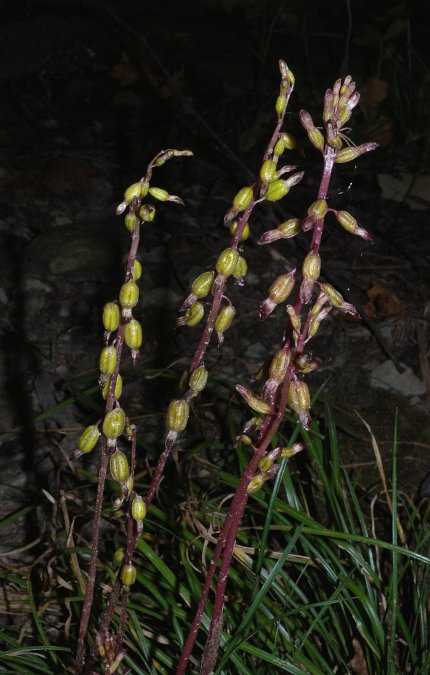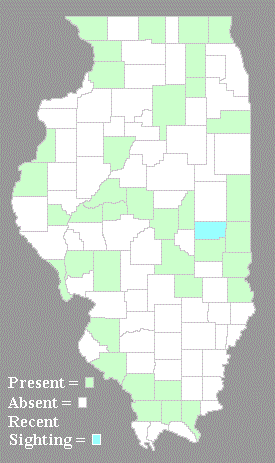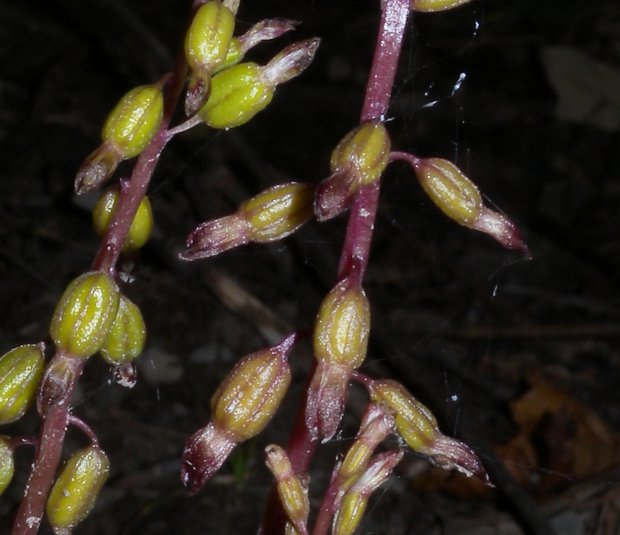
The chasmogamous flowers are about 6-8 mm. high and similarly across; the cleistogamous flowers are more narrow and tubular-angular in shape. Individual flowers of both types have 3 petaloid sepals (2 lateral sepals and an upper sepal), 3 petals (2 upper-lateral petals and a lower petal that is referred to as the lower lip), a small whitish reproductive column, and an ovary. All three sepals and the two upper-lateral petals are more or less oblong-elliptic in shape, whether the flowers are chasmogamous or cleistogamous; they are yellowish brown to reddish purple, becoming whitened at the base. The lower petal (or lip) of a chasmogamous flower is oval-orbicular in shape and finely crenate-undulate along its lateral and outer margins; it is predominately white with reddish purple spots. The lower petal of a cleistogamous flower is similar, except it is more narrow. For a chasmogamous flower, the upper sepal and upper-lateral petals form a protective hood over the reproductive column of the flower; the lateral sepals may form the lateral sides of the hood, or they may arch downward and spread outward slightly. The lower lip of a chasmogamous flower curves downward, functioning as a landing pad for visiting insects. A cleistogamous flower is tubular-angular in shape as a result of the sepals and petals joining together; the mouth of this flower is either slightly open or closed. The slender pedicels of the flowers are 2–3.5 mm. long, while the floral bracts directly underneath the pedicels are 2.5–4 mm. long, linear to linear-lanceolate in
 shape, and deciduous. The blooming
period can occur from late summer to mid-autumn, lasting about 3
weeks. Afterwards, fertile flowers are replaced by drooping seed
capsules that are 5–8.5 mm. long, broadly ellipsoid-oblongoid in
shape, 6-furrowed along their sides, and glabrous. Immature
capsules are light green or dull yellow (and sometimes reddish
purple along their
furrows), but they become brown at maturity. These capsules split open
after a hard frost to release their tiny seeds to the wind. The root
system consists of a mass of coralloid (coral-like) rhizomes that form
contorted chunky strands about 3-5 mm. across; young rhizomes are
white, while older rhizomes are brown. Older rhizomes often form buds,
from which new clonal flowering stalks can develop.
shape, and deciduous. The blooming
period can occur from late summer to mid-autumn, lasting about 3
weeks. Afterwards, fertile flowers are replaced by drooping seed
capsules that are 5–8.5 mm. long, broadly ellipsoid-oblongoid in
shape, 6-furrowed along their sides, and glabrous. Immature
capsules are light green or dull yellow (and sometimes reddish
purple along their
furrows), but they become brown at maturity. These capsules split open
after a hard frost to release their tiny seeds to the wind. The root
system consists of a mass of coralloid (coral-like) rhizomes that form
contorted chunky strands about 3-5 mm. across; young rhizomes are
white, while older rhizomes are brown. Older rhizomes often form buds,
from which new clonal flowering stalks can develop.Cultivation: The preference is moist to dry-mesic loam with decaying organic matter. Because this plant does not produce significant chlorophyll, it is relatively indifferent to sun exposure, although excessive dryness in the soil from too much sunlight is harmful to it. This plant requires the presence of ectomycorrhizal fungi (more specifically, Tomentilla spp.) in the soil, otherwise it can't develop properly. This orchid forms a parasitic relationship with such fungi, as the latter transports nutrients from both itself and from the trees with which they form a symbiotic relationship. The ectomycorrhizal fungi, Tomentilla spp., can form such relationships with various hardwood trees (oaks, hickories, and American Beech) and probably some conifer trees (pines). After a seed of this orchid germinates, it can flower in as little as 4 years under favorable conditions. Because of its dependence on specific ectomycorrhizal fungi, an adult plant is unlikely to survive transplantation to a different site.
Range & Habitat: Autumn Coralroot (Corallorhiza odontorhiza) occurs in scattered counties throughout Illinois; it is uncommon within the state overall. This orchid is widely distributed in the northeastern region of the United States, central-eastern region of the United States, and southern Ontario in Canada. Habitats include rich deciduous woodlands, wooded slopes, and pine plantations. This orchid is found in higher quality natural areas.
Faunal Associations: Plants with chasmogamous flowers are probably visited by bees, while plants with cleistogamous flowers don't require insect pollination. Some Coralroot orchids (Corallorhiza spp.) attract orchid weevils (Stethobaris ovata, Stethobaris commixta). As adults, these weevils feed destructively on sheaths, buds, and flowers, while their larvae feed from within the seedpods. It is not clear, however, if they feed on Fall Coralroot, as its flowering stalk doesn't develop until late in the year. Some mammals may feed on this orchid occasionally. For example, small rodents may dig holes to feed on the roots, while deer may browse on the flowering stalks. However, because the flowering stalks of this orchid are rather small and they don't stand out from the background, such browsing is probably uncommon.

Photographic Location: A deciduous woodland in Douglas County, Illinois. The photographed plant is Corallorhiza odontorhiza odontorhiza. Some of the cleistogamous flowers toward the apex of the racemes may be in bloom, while below the flowers are no longer in bloom. The latter have become immature seed capsules.
Comments: Because the flowers of this orchid in Illinois are usually cleistogamous, it is not very showy. Among the Coralroot orchids (Corallorhiza spp.), Autumn Coralroot (Corallorhiza odontorhiza) is the last species to bloom and it is also the smallest in size. When they occur, the chasmogamous flowers of this orchid can be distinguished from the flowers of other Coralroot orchids using the following criteria: 1) its flowers are smaller in overall size, 2) the lower lip of its flower is finely crenate-undulate, rather than smooth, along the margin, and 3) the lower lip of its flower lacks basal lobes (auricles). Another common name of this orchid is Fall Coralroot.